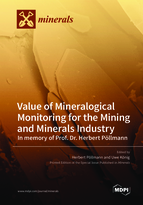Value of Mineralogical Monitoring for the Mining and Minerals Industry
A special issue of Minerals (ISSN 2075-163X). This special issue belongs to the section "Mineral Processing and Extractive Metallurgy".
Deadline for manuscript submissions: closed (22 October 2021) | Viewed by 43841
Special Issue Editors
Interests: applied mineralogy; process mineralogy; characterization techniques; raw materials; mineral synthesis; immobilization of hazardous wastes; cementitious materials; recycling
Special Issue Information
Dear Colleagues,
This Special Issue, focusing on the value of mineralogical monitoring for the mining and minerals industry, should include detailed investigations and characterizations of minerals and ores of the following fields for ore and process control:
- Lithium ores—determination of lithium contents by XRD methods;
- Copper ores and their different mineralogy;
- Nickel lateritic ores;
- Iron ores and sinter;
- Bauxite and bauxite overburden;
- Heavy mineral sands.
The value of quantitative mineralogical analysis, mainly by XRD methods, combined with other techniques for the evaluation of typical metal ores and other important minerals, will be shown and demonstrated for different minerals. The different steps of mineral processing and metal contents bound to different minerals will be included. Additionally, some processing steps, mineral enrichments, and optimization of mineral determinations using XRD will be demonstrated.
Statistical methods for the treatment of a large set of XRD patterns of ores and mineral concentrates, as well as their value for the characterization of mineral concentrates and ores, will be demonstrated. Determinations of metal concentrations in minerals by different methods will be included, as well as the direct prediction of process parameters from raw XRD data.
Prof. Dr. Herbert Pöllmann
Dr. Uwe König
Guest Editors
Manuscript Submission Information
Manuscripts should be submitted online at www.mdpi.com by registering and logging in to this website. Once you are registered, click here to go to the submission form. Manuscripts can be submitted until the deadline. All submissions that pass pre-check are peer-reviewed. Accepted papers will be published continuously in the journal (as soon as accepted) and will be listed together on the special issue website. Research articles, review articles as well as short communications are invited. For planned papers, a title and short abstract (about 100 words) can be sent to the Editorial Office for announcement on this website.
Submitted manuscripts should not have been published previously, nor be under consideration for publication elsewhere (except conference proceedings papers). All manuscripts are thoroughly refereed through a single-blind peer-review process. A guide for authors and other relevant information for submission of manuscripts is available on the Instructions for Authors page. Minerals is an international peer-reviewed open access monthly journal published by MDPI.
Please visit the Instructions for Authors page before submitting a manuscript. The Article Processing Charge (APC) for publication in this open access journal is 2400 CHF (Swiss Francs). Submitted papers should be well formatted and use good English. Authors may use MDPI's English editing service prior to publication or during author revisions.
Keywords
- lithium ore
- nickel ore
- iron ore
- iron sinter
- bauxite
- heavy mineral sands
- copper ores
- process monitoring
- mineralogy







